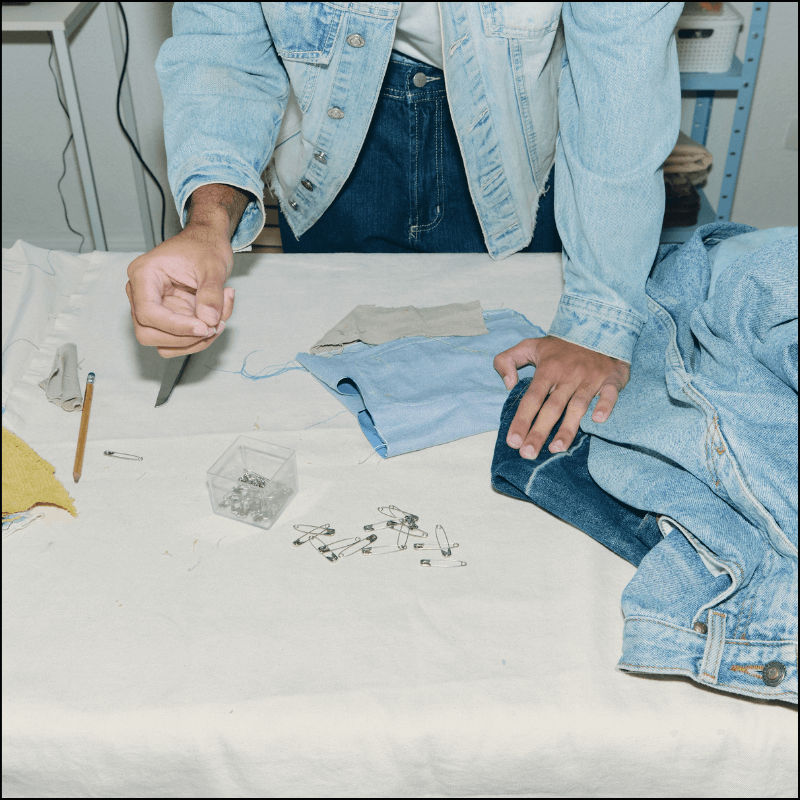Apparel Sourcing – 9 Tips For Startup Brands
This article is next-level insider info. As a fashion consultant, and a partner in a factory in India, I am sharing my best apparel sourcing tips. If you aren't quite there yet, and are still looking for the perfect garment supplier, bookmark this article for later, then jump down to the bottom for additional resources and more info on how to find the perfect supply chain partners.
BUT BEFORE WE GET STARTED...
Have you heard about the super secret document that everyone in the fashion industry uses, but no one is talking about? Probably not. That is because you can't find it on Google or Instagram (believe me, I've tried).
It's a form I have used for over 13 years at every job I have ever had. Literally everyone from brands to fabric suppliers use it, but you can't find it anywhere publicly.
The best part? It can cut your sourcing time in half, and save you tons of money in product development! This is the kind of info consultants charge the big bucks for. And, I'm giving it away for free until the end of the month.
So, get ready to make fashion startup life a whole lot easier, and GRAB YOUR FREE DOWNLOAD OF THE NOT-SO-SECRET SOURCING DOC HERE
WHAT YOU WILL LEARN IN THIS POST. . .
- The personality trait that leads to apparel sourcing success
- The trick to never having a late shipment
- What to do when things go wrong
- How good logistics can decrease your bottom line
- Preventing problems before they happen
- The one thing I would spend my last dollar on (no, it's not PR)
- Skipping this one thing could lead to a production disaster
- How to become your factories top priority
- This will save you when things go wrong
- Additional resources
1. BE FLEXIBLE

I bet as you read this, you have a dream of what your clothing company is going to look like. And, while it’s great to have a vision to help direct you toward your goals, it’s important not to get too hung up on it. Because flexibility in apparel sourcing is everything.
Here’s an example.
I had a student that wanted to make a very specific product. When she shared with the private coaching group, she got a lot of negative feedback and constructive criticism. TBH, I didn’t think it was the best idea either. But she decided to move forward with it anyway.
She wanted a very specific product, made in a very specific place, with a very specific (read teensy tiny) MOQ.
And it just wasn’t possible.
It would have been possible if she wanted to make the product in another country, but she refused. Or if she would agree to change the fiber composition in the garment, but she wouldn’t. And lastly, there was an option where she could bump up the MOQ slightly and get exactly what she wanted. But she didn’t want to go from 50 to 100 pieces.
Because she was unwilling to pivot from her original plan, her brand never launched.
Here is the thing about designing fashion: no one ever gets exactly what they want.
There will be problems with MOQs and problems with costing, and some things just aren’t possible – that’s why they don’t exist. But if you are flexible, you can still get stuff done.
And just because something isn’t exactly what you envisioned doesn’t mean your customers won’t love it.
Here’s another example. A lot of times, brands think they should not use stock fabric colors or fabrics that are available in markets. They think they should develop their own custom colors instead. But I can promise you that your sales will not be affected if the shade of blue you end up with is a little different than the shade of blue on your mood board.
Remember, stay flexible, adapt, and move forward.
2. IN THE WORLD OF APPAREL SOURCING, YOU NEED TO PAD YOUR TIMELINES

No one in fashion is ever on time. Not even the best, most reputable factories. So it’s up to you to plan ahead for this.
Don’t try to fight it. Just accept it. Things will be late, always.
To combat the inevitable delays and still deliver to clients on time, I always add about 1-2 weeks to each step of my supply chain. The amount of time I add varies depending on where and who I am working with.
So, if I am making a garment that needs custom fabric with a custom print that then needs to be sewn into a garment – 3 steps in the supply chain – I will add about 3-4 weeks (yes, an extra month of lead time to my calendar).
3. ALWAYS HAVE A PLAN B . . . and C . . .

Apparel sourcing is chaotic, and things go wrong all the time.
I was working in fast fashion and had just landed back in the U.S. after a month-long trip to Asia. Literally, as I am walking into my apartment, my boss calls me and says, “I need you to fly back tomorrow. We are having some production emergency that I need you to fix.” So I slept for a few hours, didn’t bother to unpack my bag, and returned to Asia the next day.
Now, running your own fashion brand is not going to be as insane as working in fast fashion, but I wanted to give you an example of how helter-skelter the world of apparel sourcing really is.
A lot of my students want to stop reaching out to suppliers once they find a factory to work with. But I always tell them – supply chain is a numbers game. More is better.
To get through the flurry of chaos, I always encourage brands to have a plan B and C. For example, in apparel textile sourcing, don’t stop when you find what you are looking for. Find someone else that can supply it to you if your first supplier goes out of business or jacks up your prices.
Always have another way of doing everything on the back burner.
4. KEEP EVERYTHING CLOSE

Geographically speaking.
Not your ideas (I believe in sharing those, because the more opinions you can get on your brand the better it can become). I am talking about your supply chain here.
Yes, apparel sourcing is a global business, But when it comes to geography, closer is often better.
Here are 3 big reasons why you might want to hold off on working internationally, at first…
- Transportation times are quicker and costs are cheaper, the shorter the distance. This just makes logical sense.
- Time zone changes can add weeks to your timeline. If you are based in New York and your factory is in India, you are working with an 11-hour time difference. So, if you wake up on the 5th and tell a factory you need them to do something, they won’t be able to get started until the 6th. Then, if they have a question, they will ask it during their workday when you are probably sleeping, and you will lose out on another day of work. The only way to combat this is to wake up really early and stay up super late – and who wants to do that?
- Language and cultural barriers. It’s just easier to work in a place you are familiar with. Getting into apparel sourcing is like learning a whole new language. Make your life easier by doing it in a place you are already familiar with so you don’t have to navigate cultural and geographical differences simultaneously.
Remember, keep it close when it comes to the countries you work in. But, with ideas, share, share, share, no need to keep that close to the vest!
5. TRUST YOUR GUT

This one took me a really long time to master. But now I am pretty sure I’m a witch that can predict the future (kidding, but not kidding).
There were so many times when I was just starting out with my company that I made decisions I hoped would work out. I would lay awake at night, praying that products would end up the way I needed them to. And you know what? They never did.
Something deep down inside me knew each time I made the wrong decision. And, like a toxic relationship, I was trying to force things that just weren’t meant to be.
After one particularly terrible client experience (she left me high and dry with a $15k debt), I said to Will, “I told you she was going to be a terrible client.” In retrospect, the fact that her husband was in an energy drink MLM should have been a dead giveaway. But I was just starting out and thought any client was better than no client; I would make it work.
From that moment forward, I swore to always listen to my gut. And since I have done that, my business has continued to grow every year, and I only have clients I love working with.
6. INVEST IN QA

QA stands for quality assurance. The most important part of your supply chain, IMO, is quality control.
Most mistakes in fashion manufacturing can be fixed. But only if you catch them early enough. The thing is, if you can’t be there watching your entire supply chain (and who can, we are all busy with businesses to run), then you need to hire someone else to do it for you.
No, you can’t rely on your factory. They are trying to push through your order and get paid, so sometimes, the little things slide. What you need is someone that is an impartial third party.
These third parties are also great to be your eyes and ears when you are not in the factory to make sure your supply chain partners are maintaining a high degree of work ethics and social responsibility.
Quick tip. One of my favorite quality assurance companies to work with is Intertek, and they are extremely well-known in the apparel industry.
7. NEVER SKIP SAMPLING

Correct and proceed. These words are the production kiss of death.
Whenever you are developing a new style, it is extremely important to get a perfect sample before moving into production. Because if a factory can’t get it perfect in sampling, what makes you think they will magically get it right in production?
What correct and proceed means is that whatever is wrong in the sample will be corrected in production and that another round of samples is not necessary.
Don’t do this.
It is tempting to correct and proceed because it allows you to jump right into production and save time. But when brands do this, they often end up with a giant production order that has a lot of problems.
8. PICK UP THE PHONE AND CALL

Apparel sourcing is old school. Not getting replies to your email? Pick up the phone, call, and ask for the merchandising or sales team.
IDK why apparel sourcing is this way, and it drives me nuts. But I could be waiting for an email reply for weeks. Then, when I pick up the phone and call them, I get the information I need, and my problem resolved immediately.
One of my favorite examples of this happened with my freight forwarder (the person responsible for shipping my order across the world). I asked him for a quote, and it was double what it was last time. And I was like, “This is crazy. How?” And he was like, “It is what it is. Take it or leave it.”
So I picked up the phone and called him, and was like, “What the heck is going on over there?” We went over the shipment and, over the phone, we realized that his team put the weight in double what it should be (the heavier the shipment, the higher the cost).
And, there you have it. Sometimes it’s just easier to get things done off email.
9. BUT, MAKE SURE EVERYTHING IS IN WRITING

While calling gets things done, it is also important to always have a paper record. Like I said, things will go wrong in apparel sourcing, and the paper record is what will help you get money back when they do.
If you try to say, “Well, you said this or that over the phone . . .” the factory is going to deny it. But, if you have it in writing – well, then you have a case.
So, after you hang up the phone, always send a recap email summarizing what was said during the phone conversation.
Remember, if it’s not in writing, it never happened.
ADDITIONAL RESOURCES FOR APPAREL SOURCING

- Need money to start your brand? How to find a fashion investor
- Clothing manufacturers for small orders
- What fabric suppliers want you to know
WHAT DO YOU THINK?
Do you have any other apparel sourcing tips? Let me hear them in the comments!
WANT TO WORK WITH ME?
Fill out this quick form here; it's only 11 questions!



Comments